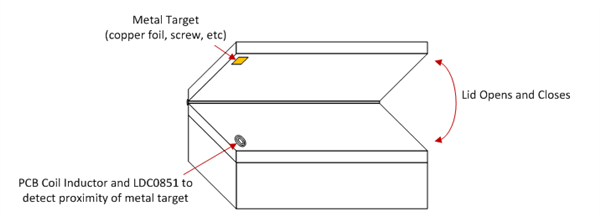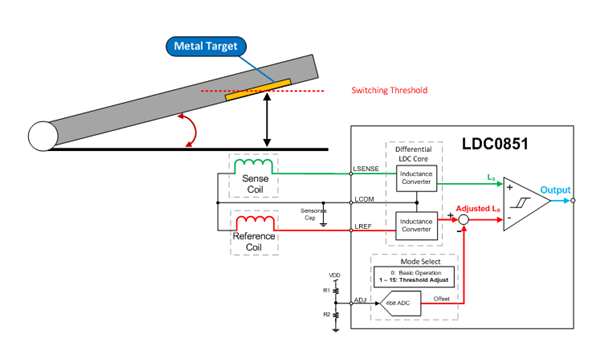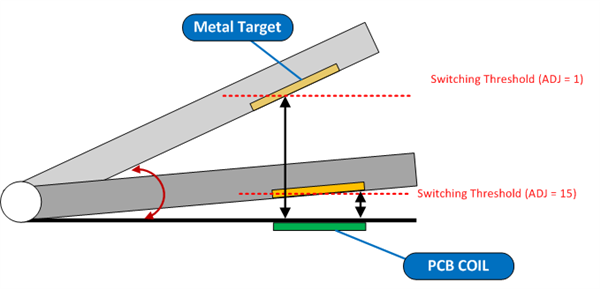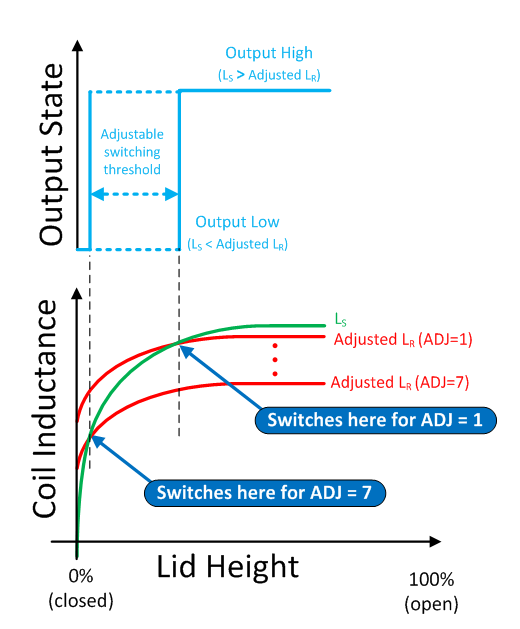SSZTB02 August 2016 LDC0851
A customer recently asked me to optimize a lid open/close detection mechanism for a consumer product. To avoid relying on potentially unreliable electrical contacts, magnets or expensive optical solutions, I suggested the LDC0851 differential inductive switch.
Today I want to show you how to use an inductive switch for this purpose and how a threshold adjustment feature can help set the switching distance.
How Can an Inductive Switch Be Used for Lid Open/close Detection?
Typical inductive proximity-sensing applications use a small metal target such as a piece of copper foil or even a screw to detect the position of a moving part such as the lid or a door of a consumer product, as shown in Figure 1.
 Figure 1 Lid Open/close Detection
Application
Figure 1 Lid Open/close Detection
ApplicationTo determine if metal is present, the switch compares the inductance of a sense coil to the reference coil. The outer coil diameter determines the maximum switching threshold.
I suggested a stacked coil approach, in which printed circuit board (PCB) layers 1 and 2 contain the sense coil and layers 3 and 4 contain the reference coil. Figure 2 shows a system block diagram.
 Figure 2 System Block Diagram
Figure 2 System Block DiagramWhen Should I Use Threshold Adjust Mode?
In proximity applications, it is important to determine if the LDC0851 should operate in basic operation mode or threshold adjustment mode:
- In basic operation mode (ADJ = 0), the LDC0851 uses a reference target positioned at a fixed distance from the reference coil and a moving target over the sensor coil. Unfortunately, the reference target is not easy to add in this system.
- You must use threshold adjust mode (1 ≤ ADJ ≤ 15) if there is no fixed target present near the reference coil. In this mode, the reference coil inductance has an offset subtracted to alter the switching threshold. Operating in threshold adjust mode ensures that the sense coil inductance is greater than the reference coil inductance at an infinite target distance, and therefore that the release point is well defined. This is the case in both stacked coil application and side-by-side coil applications. Within threshold adjust mode, ADJ = 1 produces the largest sensing range and ADJ = 15 the smallest, as shown in Figure 3. Note that the switching distance is also a function of the outer coil diameter.
 Figure 3 Different ADJ Codes Affect the
Switching Threshold
Figure 3 Different ADJ Codes Affect the
Switching ThresholdConfiguring the LDC0851 for threshold adjust mode requires setting a resistor divider on the ADJ pin. The ADJ pin has 16 levels (level 0 disables the threshold adjust feature, and is equivalent to basic operation mode). The LDC0851 data sheet contains the recommended resistor values for each level. Figure 4 shows how the lid height and ADJ code affect the adjusted coil inductance.
 Figure 4 Lid Height vs. Coil Inductance and ADJ Code
Figure 4 Lid Height vs. Coil Inductance and ADJ CodeWith the LDC0851, I was able to help the customer with a simple and reliable solution. Not all inductive proximity-switch applications have a metal target near the reference coil to set the switching point, however. In applications without a reference target, the threshold adjust mode ensures that switching occurs at the desired target distance. What’s your experience designing with inductive switches? Login and leave a comment below.
Additional Resources
- View the LDC0851 data sheet.
- Download the Inductive Sensing Design Calculator Tool, which includes a dedicated tab to configure an LDC0851.
- Read other blogs about inductive sensing.